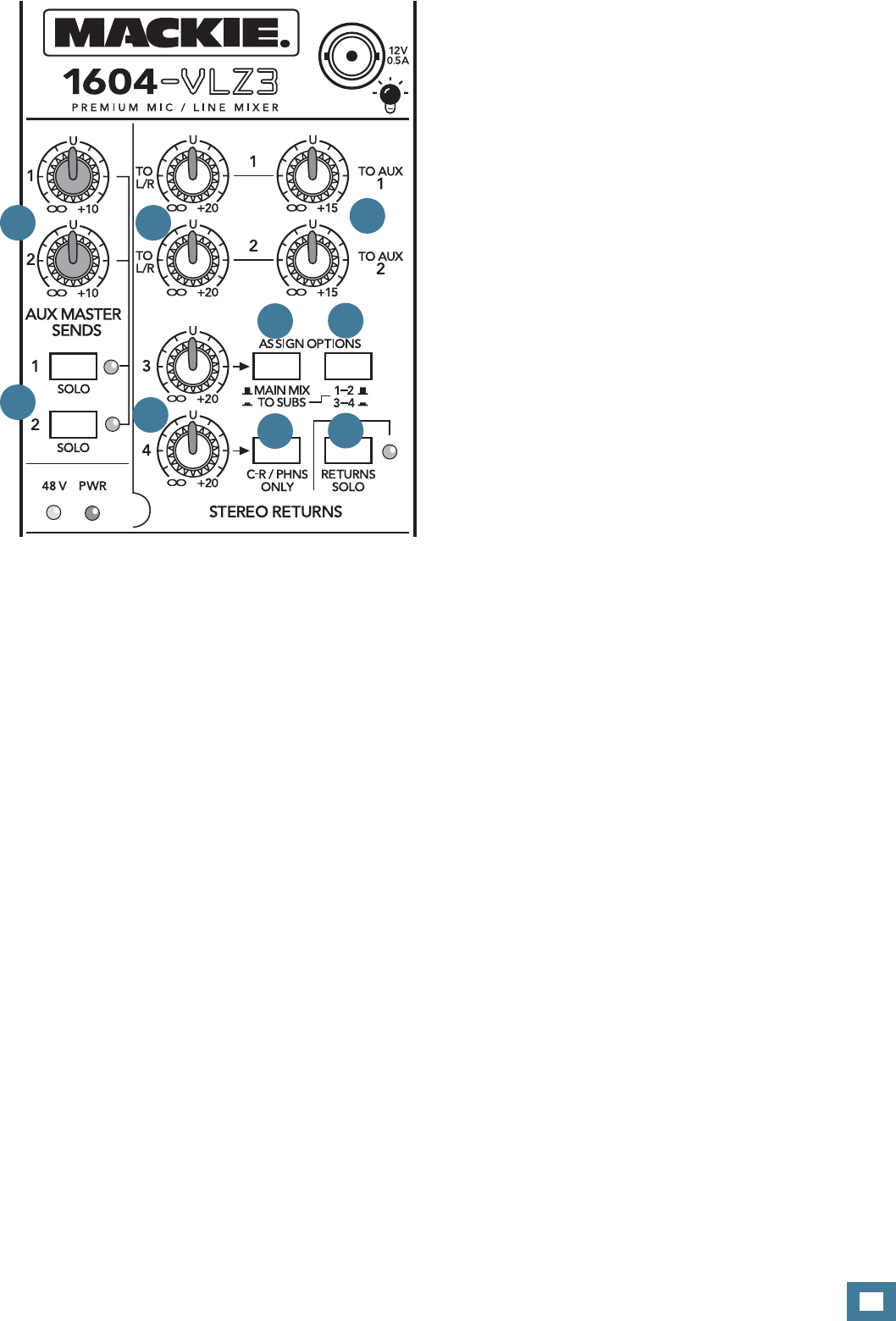
23
Owner’s Manual
Owner’s Manual
AUX TALK
SENDS are outputs, RETURNS are inputs. Each
channel's AUX [34] knobs tap the signal off the channel
and send it to the AUX SEND [6] outputs. AUX 1 and 2
are sent to the AUX SENDS 1 and 2 [49] master knobs
before the AUX SEND outputs; AUX 3 through 6 are sent
directly.
These outputs can be fed to the inputs of a reverb or
other device. From there, the outputs of the external
device are fed back to the mixer’s STEREO RETURN [7]
inputs. Then these signals are sent through the STEREO
RETURN [51] level controls, and fi nally delivered to the
main mix.
So, the original “dry” signals come from the channels
to the main mix, and the affected “wet” signals come
from the STEREO RETURNS to the main mix, and once
mixed together, the dry and wet signals combine to cre-
ate a glorious sound. Armed with this knowledge, let’s
visit the Auxiliary World:
49. AUX SENDS (MASTER)
These knobs provide overall level control of AUX
SENDS 1 and 2, just before they’re delivered to their
AUX SEND [6] outputs. This is perfect for controlling
the level of stage monitors, since you’ll be using AUX 1
and 2 for this, with their PRE [35] switches engaged.
AUX SENDS 3 through 6 have no such control — they’ll
just send their mixes directly to their respective AUX
SEND outputs at unity gain.
These knobs go from off (turned fully down), to unity
gain at the center detent, with 10 dB of extra gain
(turned fully up). As with some other level controls, you
may never need the additional gain, but if you ever do,
you’ll be glad you bought a Mackie.
This is usually the knob you turn up when the lead
singer glares at you, points at his stage monitor, and
sticks his thumb in the air. (It would follow suit that if
the singer stuck his thumb down, you’d turn the knob
down, but that never happens.)
50. AUX SENDS SOLO
Once again, in live sound situations AUX SEND 1 and
2 are likely to feed your stage monitors. You’ll want to
check the mix you’re sending them, and that’s what
these two buttons are for. (AUX 3 through AUX 6 have
no such switch.) Beside each switch is a green LED
that, just like the channel’s –20 LED [28], helps you
fi nd the rogue SOLO switch.
The only thing different about AUX SENDS SOLO is
that it’s not really PFL (pre-fader listen), and it’s not
really SIP (solo-in-place), it’s actually AFL (after-fader
listen). During NORMAL (AFL) [44] mode , you’ll
get AUX SEND 1’s solo signal, post-AUX SENDS [49]
master level, in the left side of the control room outputs,
phones output and meter display, and AUX SEND 2 on
the right side. (If you ever use AUX 1 and 2 to create a
stereo monitor mix, you’ll understand why.) In LEVEL
SET (PFL) mode, you’ll get the signal dead-center, but
still post-AUX SENDS master level.
51. STEREO RETURNS (LEVEL)
These four controls set the overall level of effects
received from the STEREO RETURN [7] input jacks.
These controls are designed to handle a wide range of
signal levels — each knob goes from off, to unity gain at
the detent, to 20 dB gain fully clockwise, to compensate
for low-level effects. Signals passing through these level
controls will proceed directly to the MAIN MIX FADER
[37], with exceptions that we’ll discuss in a moment.
Typically, these knobs can just live at the center
detent, and the effects device’s output control should
be set at whatever they call unity gain (check their
manual). If that turns out to be too loud or too quiet,
adjust the effects device’s outputs, not the mixer. That
way, the mixer’s knobs are easy to relocate at the center
detent.
51
51
52
53
54
55
56
49
50


















